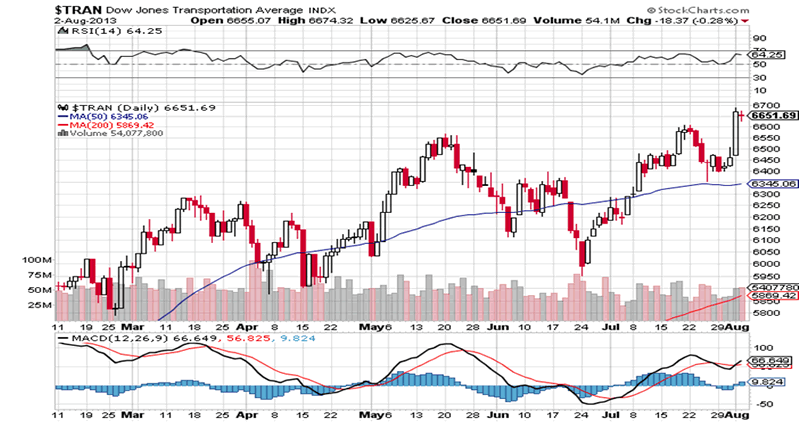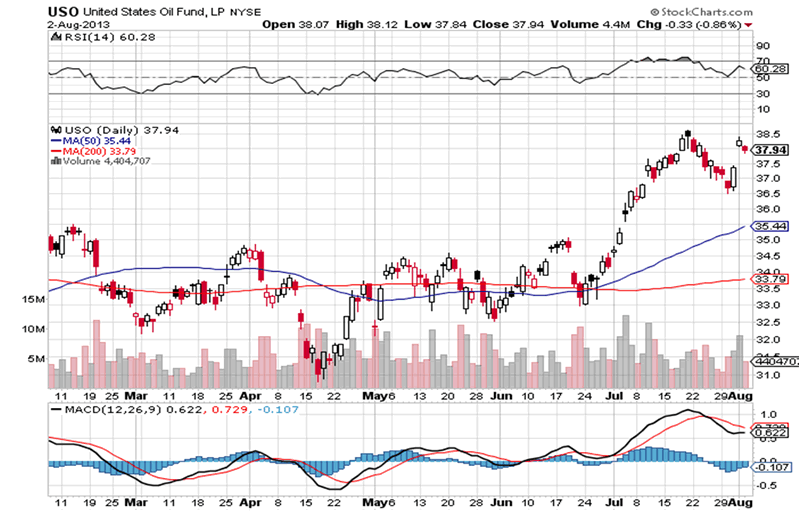Detroit and Social Credit, Stocks Contnuing Technical Strength
Stock-Markets / Financial Markets 2013 Aug 05, 2013 - 06:21 PM GMT In 2009 I wrote an essay on Social Credit which for some reason has become one of the most popular articles I have ever penned. This, I reckon, is not because it is a particularly “exceptional” essay but due, in part, to timing. Interest in this “economic concept” has recently gone “viral”.
In 2009 I wrote an essay on Social Credit which for some reason has become one of the most popular articles I have ever penned. This, I reckon, is not because it is a particularly “exceptional” essay but due, in part, to timing. Interest in this “economic concept” has recently gone “viral”.
However, it is ironic that Detroit has recently filed for bankruptcy. Research for the piece I wrote on Social Credit helped me discover that it was in the environs of Detroit that the “American Dream” was made manifest by non-other than Henry Ford. Unfortunately it would appear that the lessons that should have been learned from the perspective of Social Credit have been ignored and accordingly the “American Dream” is dying. This is a tragedy. But it is never too late to start anew. As the saying goes: “when you lose, don’t lose the lesson”. To mark this seminal event in the social and economic history of Detroit I outline below the essential essence contained in that 2009 essay. Hopefully the economic truths contained therein, originally championed by Major Clifford Douglas in 1910, will continue to gain appeal and thereby motivate some future administration to take up the baton of reform and instigate credit policies that will help pass on the “American Dream” to new generations.
“What is the main objective of Social Credit? In essence it seeks to fairly compensate citizens with real purchasing power and thus end the current "trans-national/out-sourcing" industrial policy of American and European business leaders. It seeks to replace capital investment (i.e. investment in technology) with human investment.
Why is purchasing power so important? It is fundamental because without money no exchange can take place. In order to understand what I am talking about let us look at the historical example set by Henry Ford in Detroit in 1920. He completely redefined "classical" economics through the policies undertaken by the Ford Motor Company.
Under "normal" economic theory it was assumed that a corporation could only maximise profits by ideally becoming a monopoly which meant increasing price and limiting supply. Ford did the exact opposite. He had a more holistic view of the role of the corporation in society. He understood the synergetic relationship between money and goods. He DOUBLED the wages of his workers, DECREASED the price of the Model T and in the process remade the Ford Motor Corporation and remade America. (This policy was not inflationary because he knew he could at least double production through increased efficiencies when he doubled wages. This is the essence of the enlightened policy of Social Credit for communities rather than of monopoly credit for social elites alone).
The Ford Company boomed. How did this happen? It was axiomatic. He understood the importance of money and purchasing power in society. With "high" wages Ford's workers were able to make a good living and have excess funds to save or spend. Accordingly their financial anxiety ceased and staff turnover dropped by a multiple of five in one year. This dramatically decreased management expense and increased productivity. Workers finally had peace of mind. With the increased disposable income in the Detroit area the general economy boomed. All classes of economic sectors expanded. As a result more workers, new business owners, company managers, insurance brokers, real estate brokers, bankers, salesmen, craftsmen, delivery men, builders, farmers and retailers all could afford Ford cars. Demand for the model T exploded through the increased buying power WHICH HE HAD CREATED THROUGH MONEY DISTRIBUTION.
Like Major Clifford Douglas, the mind behind Social Credit, Ford understood economics and he understood the issue of PURCHASING POWER. FOR HIM PURCHASING POWER WAS NOT CREDIT BUT CASH. HE REASLIZED THAT WITHOUT THE MONEY TO PURCHASE HIS CARS POTENTIAL DEMAND WAS IRRELEVANT. THEREFORE HE INITIALLY REDISTRIBUTED DIVIDENDS FROM THE OWNERS TO THE WORKERS. THIS INCREASED GENERAL BUSINESS ACTIVITY AND TURNOVER EXPONENTIALLY. THESE INCREASED SALE BOOSTED PROFITS TO SUCH A DEGREE THAT THE SAME OWNERS EVENTUALLY RECEIVED INCREASED SUSTAINABLE DIVIDENDS. EVERYBODY WON. THIS BRILLIANT POLICY MADE THE COMPANY. It built up the economy of Detroit and it helped define America as a country where a factory worker was respected and well paid, not exploited, as had been the case throughout the English industrial revolution. The "American Dream" was Ford’s vision made manifest. It was a dream brought to fruition not through political fantasy but through the hard laws of economics, accounting, finance, production, distribution and marketing.”
To reiterate, in my view the “death” of Detroit is the unmistakable sign the “The American Dream” is dying on its feet. Unless the policies of off-shoring American jobs and the systematic lowering of American working wages cease we are going to see many more U.S. cities going bankrupt.
Social Credit as a policy may not have all the solutions to our contemporary economic crises but it has a part to play. Mainly it is helping people realise that fallacy of championing the use of technology without a concomitant policy in place to distribute money to consumers. Thus as a matter of expediency without the introduction of a National Dividend to stimulate American purchasing power contemporary modernity is going to continue to experience social disintegration. However, for some reason governments cannot seem to come to terms with the “radicalness” of this solution. Radical or not, the truth of the matter is you either “adapt or die” and unfortunately the tragedy of the Detroit bankruptcy saga proves that America is opting to die.
Technical Strength Continues For Now.
The market, though over-bought, continues to show exceptional technical strength.
The strategy of going long on pullbacks and selling into highs remains in place.
How long this approach continues to provide excellent returns is anyone’s guess but one should not “fight a gift horse in the mouth”.
Of the Transports and the Industrials, the Trannies is the strongest Index of the two, despite rising oil prices. Case in point, observe the powerful bullish engulfing candlestick price action on the Transport Index last Friday. It would appear that the Industrials are keen to follow, we shall wait and see. One would have thought that since we are coming to the end of this earnings season there would be a serious pullback, but no, not as we speak.
As reported previously this market strength is not based on fundamentals but on technicals. The FED is walking a tightrope with its QE strategy. How the FED finally gets itself out of the box it has constructed around its policy remains to be seen. Rationally one would assume that when Government debt stops being monetized interest rates will explode. The Gold bear is actually indicating that interest rates could go into double digits soon. Such an event would cripple any real estate “recovery”, seriously negatively alter valuations on dividend paying equities, and push debt crippled European sovereign budgets into fresh crises. However, currently the market is not interested in such “logical consequences”. Therefore traders and investors should “soldier on” and take advantage of the “party” while it lasts, for it cannot go on forever. Reversion to the historical price-earning-ratio-mean is inevitable. Technical analysis will indicate to keen observers when this setup is unfolding. For the moment mean reversion is off the technical radar but as is the nature of this profession we will only believe what we see not what we hear.
Dow Transports: Daily

USO: United States OIL Fund ETF: Daily

Charts: Courtesy of StockCharts.Com
Ref: “Robots Don’t Buy Cars: Henry Ford and Social Credit” 2009 Christopher M. Quigley
By Christopher M. Quigley
B.Sc., M.M.I.I. Grad., M.A.
http://www.wealthbuilder.ie
Mr. Quigley was born in 1958 in Dublin, Ireland. He holds a Bachelor Degree in Accounting and Management from Trinity College Dublin and is a graduate of the Marketing Institute of Ireland. He commenced investing in the stock market in 1989 in Belmont, California where he lived for 6 years. He has developed the Wealthbuilder investment and trading course over the last two decades as a result of research, study and experience. This system marries fundamental analysis with technical analysis and focuses on momentum, value and pension strategies.
Since 2007 Mr. Quigley has written over 80 articles which have been published on popular web sites based in California, New York, London and Dublin.
Mr. Quigley is now lives in Dublin, Ireland and Tampa Bay, Florida.
© 2013 Copyright Christopher M. Quigley - All Rights Reserved
Disclaimer: The above is a matter of opinion provided for general information purposes only and is not intended as investment advice. Information and analysis above are derived from sources and utilising methods believed to be reliable, but we cannot accept responsibility for any trading losses you may incur as a result of this analysis. Individuals should consult with their personal financial advisors before engaging in any trading activities.
Christopher M. Quigley Archive |
© 2005-2022 http://www.MarketOracle.co.uk - The Market Oracle is a FREE Daily Financial Markets Analysis & Forecasting online publication.



